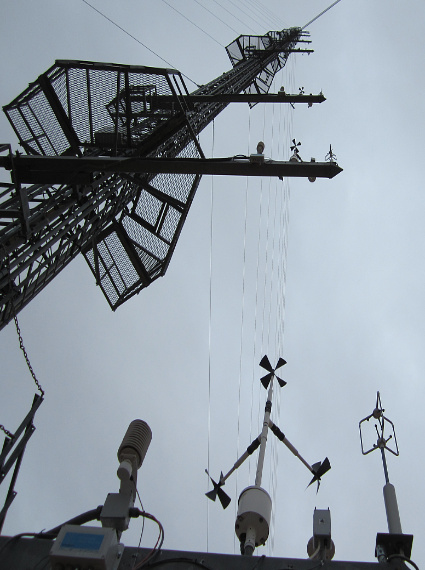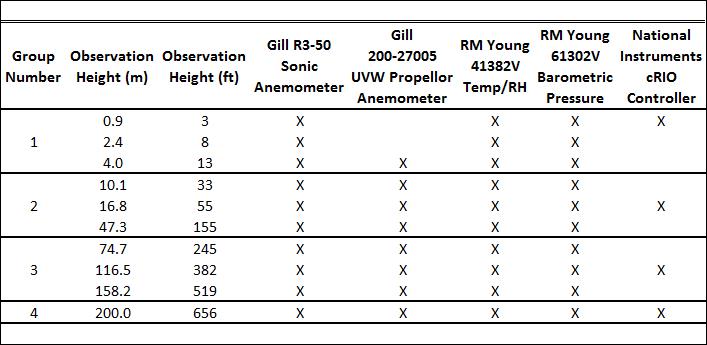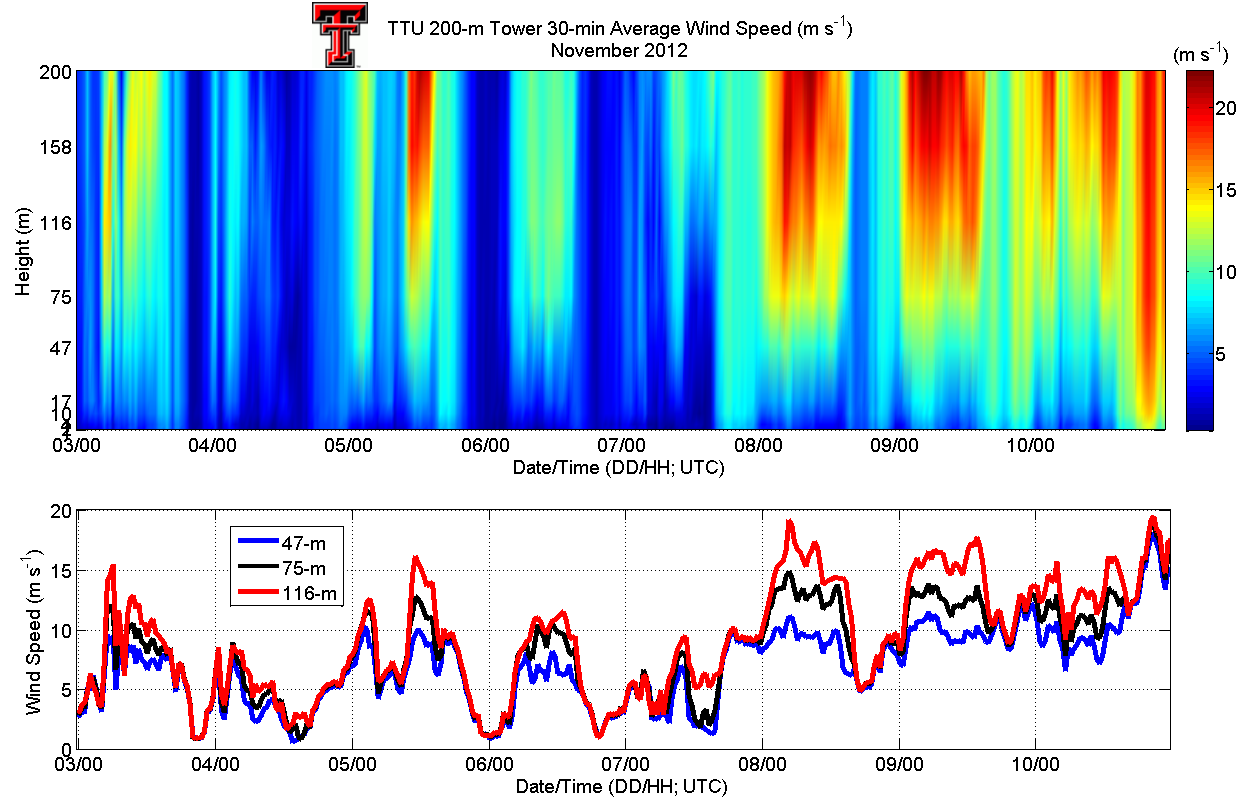200 Meter Meteorological Tower
A 200-meter meteorological tower is available to measure atmospheric conditions at 10 levels above ground level. The measurements include wind speed and direction, temperature, relative humidity and barometric pressure. The data acquisition system for the tower samples all channels of measurements 24/7 at 50 HZ.
The ability to measure wind speeds and other atmospheric conditions at multiple levels allows TTU researchers to gain fundamental knowledge about boundary layer stability, low-level jets, thunderstorm outflows, and other atmospheric events.

Tower Specification:
- Tower design: Four foot triangular lattice
- Boom arms: 14 foot square tubing
- Lightning protection: Erico Dynasphere
- FAA lighting
- Elevator
Data Acquisition and Sensors:

Case Study #1: Low-Level Jets:
Low-level jets are commonly occurring phenomena across the southern Plains. The TTU 200-m tower is well suited to record such events. The low-level jets are important for the rapid transport of low-level moisture, and can also lead to significant low-level wind shear that have meaningful loading impacts for utility scale wind turbines. As shown in the seven-day plot below, low-level jets of varying intensity can occur on a near daily basis providing rapid changes in wind speed both in height and in time. The multiple measurement levels of the TTU 200-m tower allow for excellent capture of low-level jet events.

Case Study #2: Thunderstorm Outflow Low-Level Profiles:
The outflow winds of thunderstorms are known to at times significant modify the lower atmospheric wind structure. Understanding the structure and evolution of thunderstorm outflow driven impinging jets, like that measured in May 2015 by the TTU 200-m tower (right), is vital to improving building design codes so that structures are more resilient to extreme wind events. The ruggedized nature of the TTU 200-m tower allows for reliable wind measurements during extreme weather conditions.
Federally Funded Projects:
- NSF: Reliability-based Predictions of Extreme and Fatigue Responses of Utility-scale Wind Turbines through Advanced Modeling and Simulations (Chen, $240k).
- DOE: Enhancing Short Term Wind Energy Forecasting for Improved Utility Operations (Schroeder, Ancell, $385k).
- NSF: Assessing Probabilistic Extreme and Fatigue Responses of Wind-Excited Structures: Integration of both Uncertainty and Directionality with a System Perspective (Chen, $298k).
- DOE: Development of Innovative Control Systems for Offshore Wind Turbine Performance and Reliability (Zuo, Schroeder, $223k).
Technical Publications:
- Christopher L. Kelley, Brandon L. Ennis (2016). SWiFT Site Atmospheric Characterization, SAND2016-0216, January 2016, Prepared by Sandia National Laboratories, Albuquerque, New Mexico.
- Marathe, N., Swift, A., Hirth, B., Walker, R., & Schroeder, J. (2015). Characterizing power performance and wake of a wind turbine under yaw and blade pitch. Wind Energy.
- Kiliyanpilakkil, V. P., Araya, G., Basu, S., Gutierrez, W., & Castillo, L. (2014). Identifying turbulent coherent structures during LLJ events. Bulletin of the American Physical Society, 59.
- Zuo, D., Smith, D. A., & Mehta, K. C. (2014). Experimental study of wind loading of rectangular sign structures. Journal of Wind Engineering and Industrial Aerodynamics, 130, 62-74.
- Lombardo, F. T., Smith, D. A., Schroeder, J. L., & Mehta, K. C. (2014). Thunderstorm characteristics of importance to wind engineering. Journal of Wind Engineering and Industrial Aerodynamics, 125, 121-132.
- Gunter, W. S., Schroeder, J. L., & Hirth, B. D. (2015). Validation of Dual-Doppler Wind Profiles with in situ Anemometry. Journal of Atmospheric and Oceanic Technology, 32(5), 943-960.
- McNeill, J. C. K. (2012). Characterization and simulation of inhomogeneous and non-stationary turbulent wind fields for assessment of wind turbine reliability (Doctoral dissertation, Texas Tech University).
- Berg, J., Bryant, J., LeBlanc, B., Maniaci, D., Naughton, B., Paquette, J., & Kroeker, D. (2014). Scaled Wind Farm Technology Facility Overview. In 32nd ASME Wind Energy Symposium.
- Orwig, K., Clark, C., Cline, J., Benjamin, S., Wilczak, J., Marquis, M., ... & Freedman, J. (2012, November). Enhanced Short-Term Wind Power Forecasting and Value to Grid Operations. In 11th Annual Int. Workshop on Large-Scale Integration of Wind Power into Power Systems.
Points of Contact:
- Dr. Delong Zuo for data access and usage
- Dr. Brian Hirth for instrumentation
- Mr. Jeff Livingston for maintenance and safety
National Wind Institute
-
Address
1009 Canton Ave., MS 3155 Lubbock, TX 79409-3155 -
Phone
National Wind Institute - 806.742.3476; Renewable Energy - 806.742.6284 -
Email
National Wind Institute - nwi@ttu.edu; Renewable Energy - windenergy@ttu.edu
